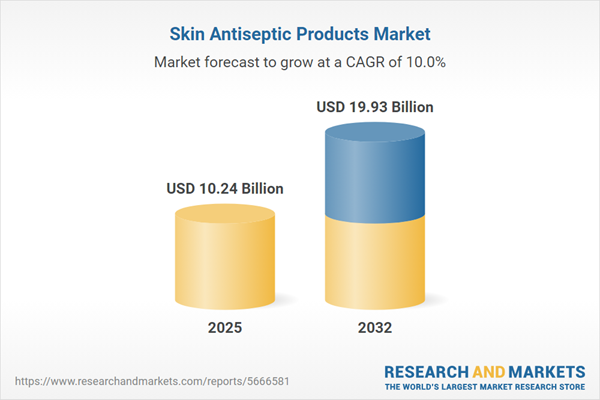Speak directly to the analyst to clarify any post sales queries you may have.
Senior healthcare leaders face growing complexity in clinical protocols, supply chain strategy, and regulatory demands. The skin antiseptic products market stands at the forefront of these changes, shaping safer patient outcomes and operational excellence across all healthcare environments.
Market Snapshot: Skin Antiseptic Products Market
The skin antiseptic products market grew from USD 9.33 billion in 2024 to USD 10.24 billion in 2025. It is expected to continue growing at a CAGR of 9.95%, reaching USD 19.93 billion by 2032. Robust growth is driven by evolving infection prevention practices, adoption of advanced formulations, and broadening end-use cases across geographies.
Scope & Segmentation
This executive analysis covers comprehensive segments, technology innovations, and geographic differences driving the market’s development:
- Product Forms: Foam, gel, solution (alcohol-based and aqueous), spray, and wipes are the core delivery categories, each tailored to distinct clinical applications from rapid coverage to extended skin contact.
- Active Ingredients: Choices include alcohol-based solutions, chlorhexidine gluconate, hydrogen peroxide, and povidone iodine, influencing both performance profiles and regulatory preferences.
- End Users: Focus extends across ambulatory surgical centers, clinics, home care, private hospitals, and public hospitals, acknowledging unique protocols and supply priorities in each.
- Distribution Channels: Direct sales, drugstore pharmacies, hospital pharmacies, company websites, and eCommerce platforms drive varied access strategies and inventory management.
- Applications: The primary application areas encompass catheter site preparation, general skin cleansing, hand antisepsis, and preoperative skin prep, including catheter insertion and surgical site cases.
- Regional Coverage: Market insight spans the Americas, Europe, the Middle East, Africa, and Asia Pacific, including detailed analysis of leading and emerging countries within each geography.
- Company Developments: Industry participants such as 3M Company, Johnson & Johnson, Ecolab Inc., Cardinal Health, STERIS, Smith & Nephew, and others are profiled, with visibility into portfolio expansion and strategic partnerships.
Key Takeaways for Decision-Makers
- Skin antiseptic products serve as the primary defense against hospital-acquired infections and procedural complications, reflecting their essential role in modern patient safety programs.
- Advances like rapid-drying foams, wipes, and integrated delivery systems enable tailored and efficient infection control in high-volume, multi-setting environments.
- Ingredient innovation responds to diverse needs, with a shift toward biocompatible actives and low-irritant formulations catering to sensitive populations and outpatient care settings.
- Emerging technologies, including smart dispensing and digital compliance tracking, are now influencing procurement priorities and contract negotiations, supporting real-time compliance.
- Market leaders build competitive edges through value-based contracting, bundled services, and evidence-based clinical resources, addressing both budgetary and clinical objectives.
- Strategic alliances, targeted acquisitions, and sustainability-focused development are transforming product pipelines in response to environmental and patient-centered procurement trends.
Tariff Impact and Supply Chain Resilience
Recent United States tariff changes have increased import duties on key raw materials, prompting production realignments and supplier diversification. Some manufacturers are investing in domestic facilities, while others strengthen partnerships with suppliers in tariff-exempt regions. This movement emphasizes the importance of robust supply chain design and adaptive procurement strategies to manage rising costs without reducing market access or clinical availability.
Research Methodology & Data Sources
Findings are based on a rigorous blend of secondary research, expert interviews, and targeted end-user surveys. Analytical approaches, including statistical validation and peer review, ensure high standards for reliability and market relevance. This report’s conclusions are grounded in a synthesis of shipment data, regulatory reports, industry publications, and first-hand perspectives from key industry stakeholders.
Why This Report Matters
- Enables strategic planning informed by segmentation intelligence and real-world adoption trends, advancing market entry and expansion decisions.
- Supports risk mitigation with detailed analysis of tariff, regulatory, and supply chain challenges, helping organizations safeguard operational continuity.
- Provides actionable, evidence-based recommendations for optimizing procurement, innovation, and clinical implementation initiatives across diverse healthcare environments.
Conclusion
The skin antiseptic products market is marked by rapid change and multifaceted growth opportunities. Leadership teams can leverage these insights to guide investment, anticipate regulatory shifts, and align with evolving standards in infection prevention and supply management.
Additional Product Information:
- Purchase of this report includes 1 year online access with quarterly updates.
- This report can be updated on request. Please contact our Customer Experience team using the Ask a Question widget on our website.
Table of Contents
3. Executive Summary
4. Market Overview
7. Cumulative Impact of Artificial Intelligence 2025
List of Figures
Samples

LOADING...
Companies Mentioned
The key companies profiled in this Skin Antiseptic Products market report include:- 3M Company
- Johnson & Johnson
- Becton, Dickinson and Company
- Ecolab Inc.
- Cardinal Health, Inc.
- STERIS plc
- ConvaTec Group PLC
- Smith & Nephew plc
- Mölnlycke Health Care AB
- GOJO Industries, Inc.
Table Information
| Report Attribute | Details |
|---|---|
| No. of Pages | 188 |
| Published | October 2025 |
| Forecast Period | 2025 - 2032 |
| Estimated Market Value ( USD | $ 10.24 Billion |
| Forecasted Market Value ( USD | $ 19.93 Billion |
| Compound Annual Growth Rate | 9.9% |
| Regions Covered | Global |
| No. of Companies Mentioned | 11 |









